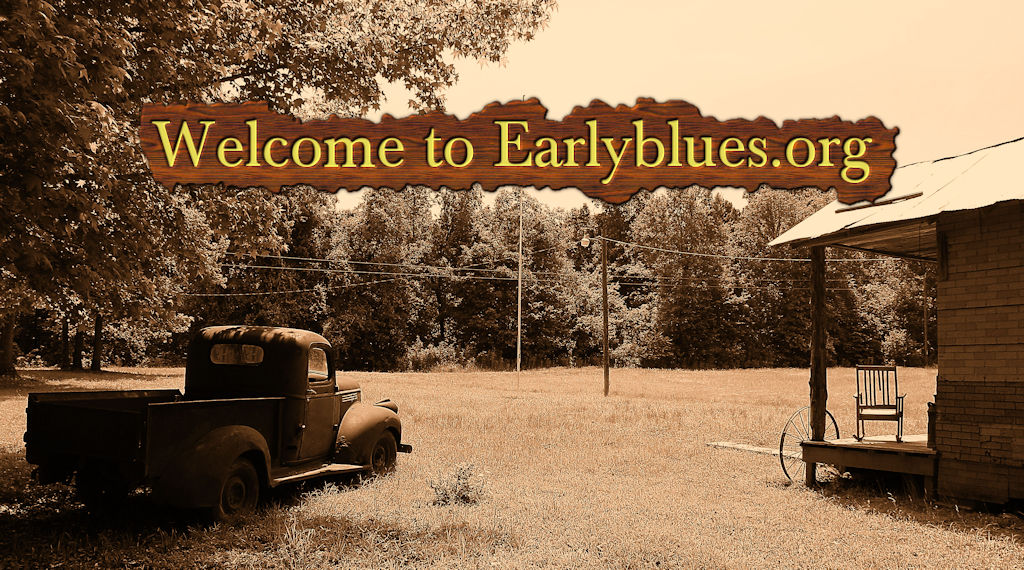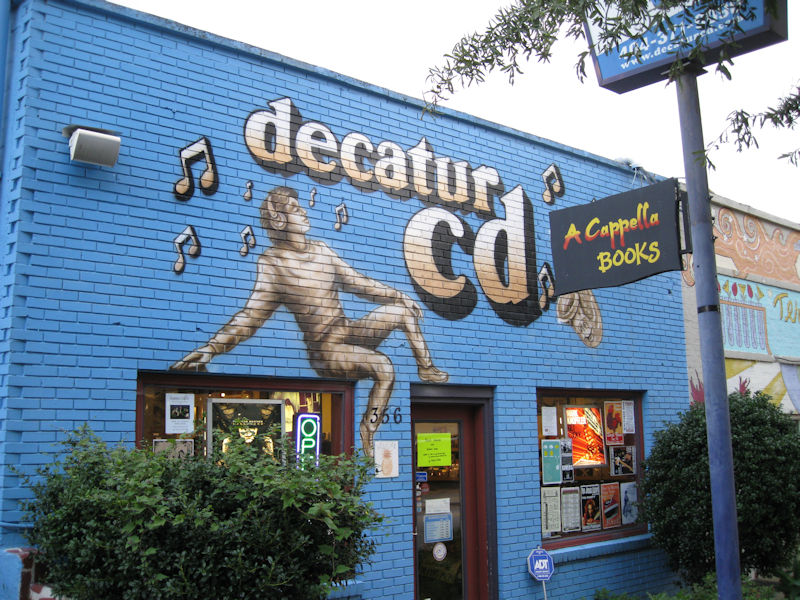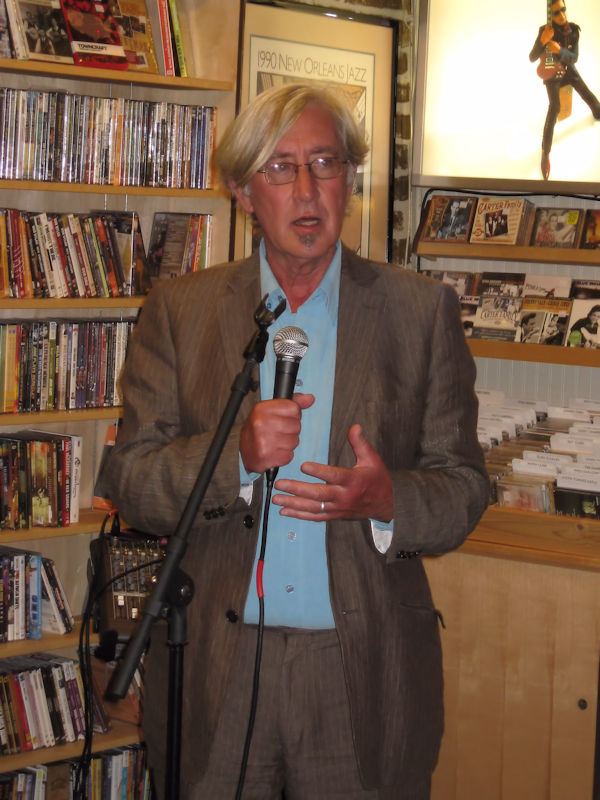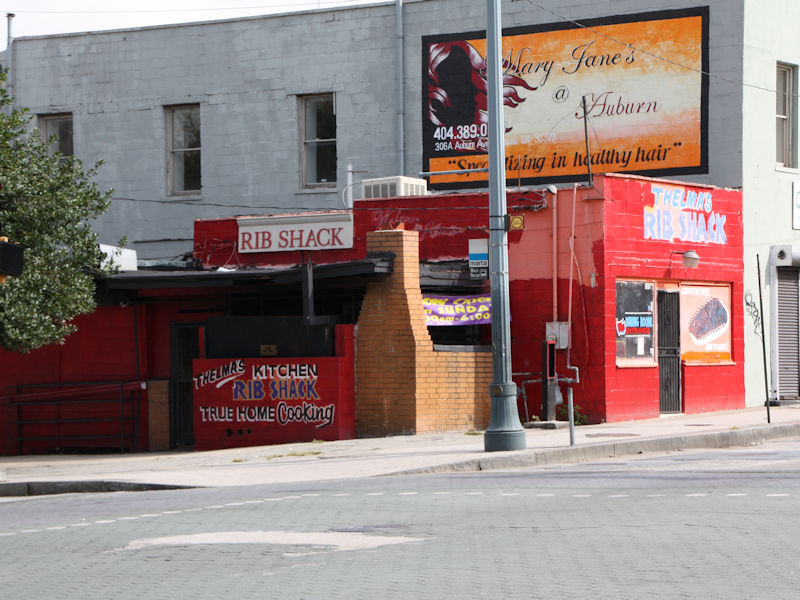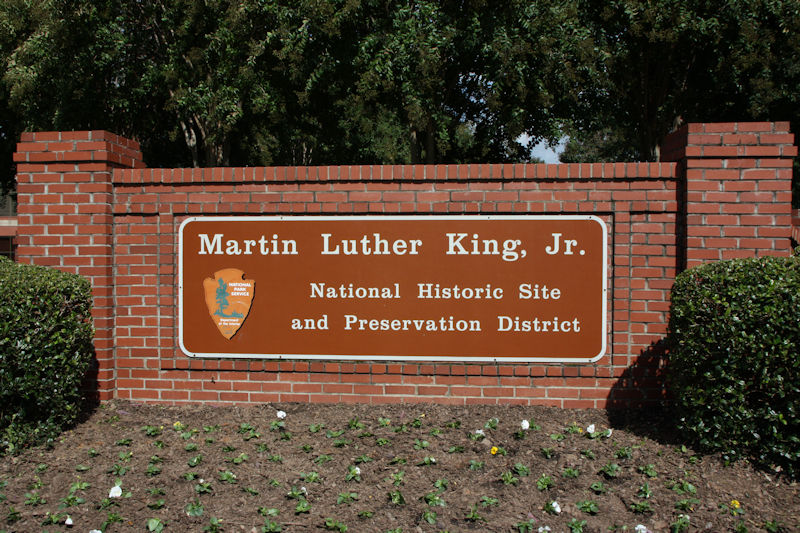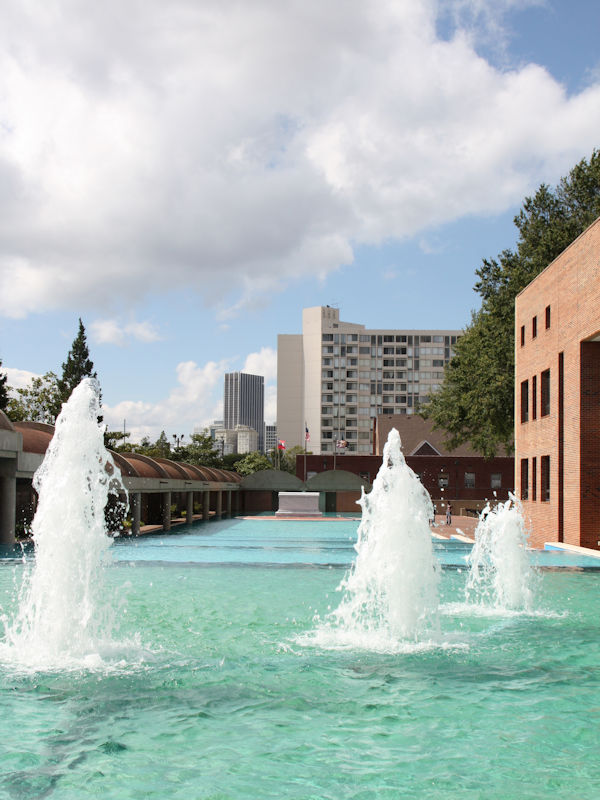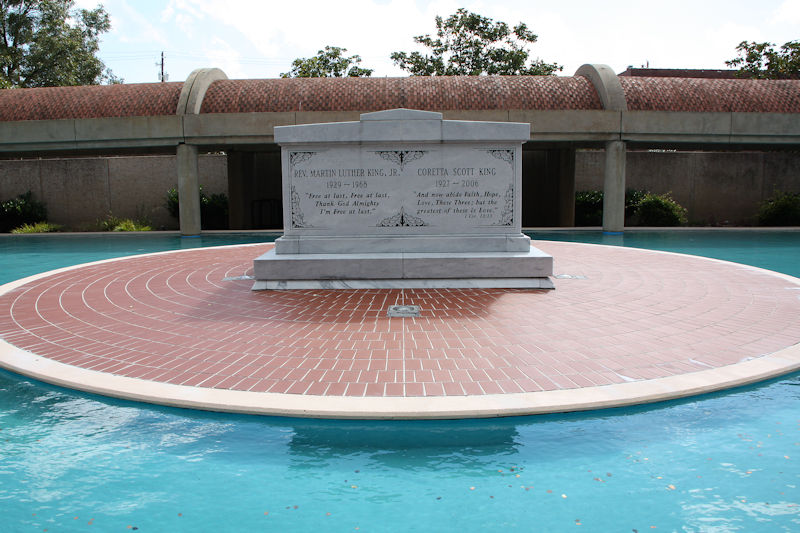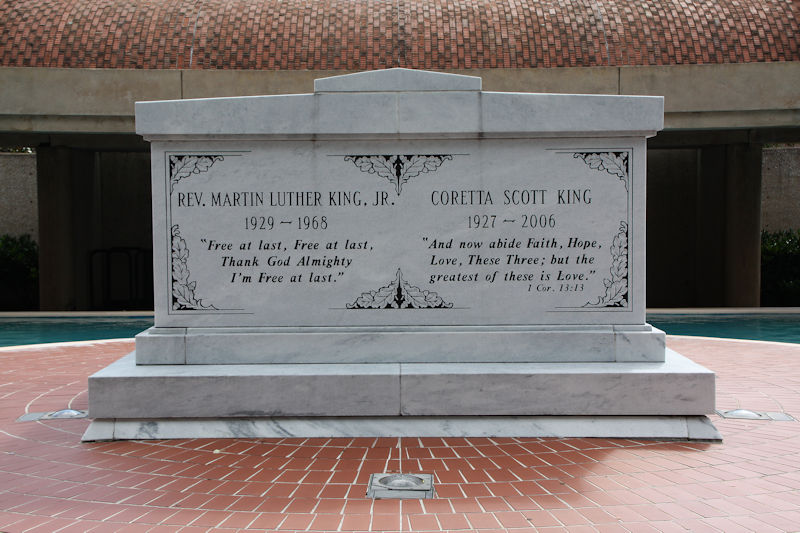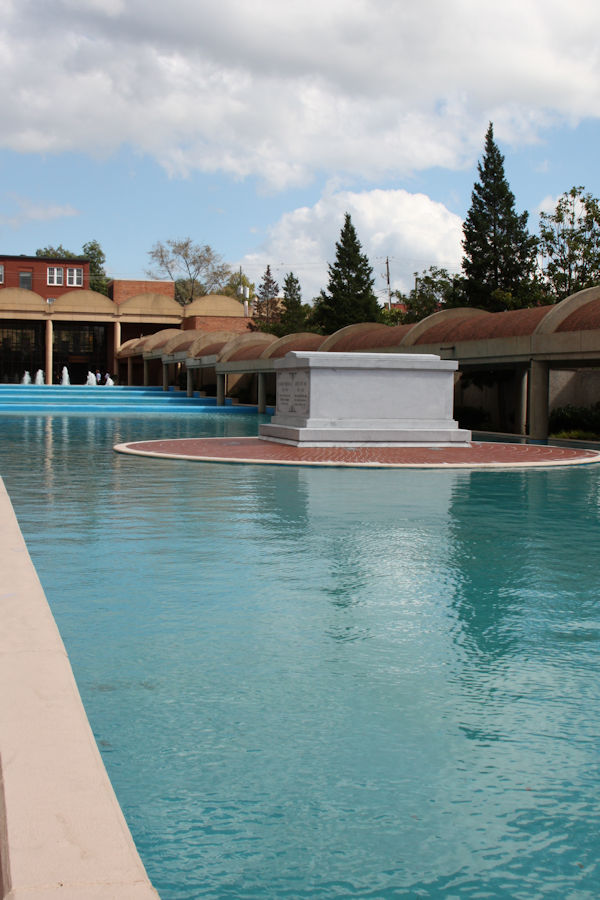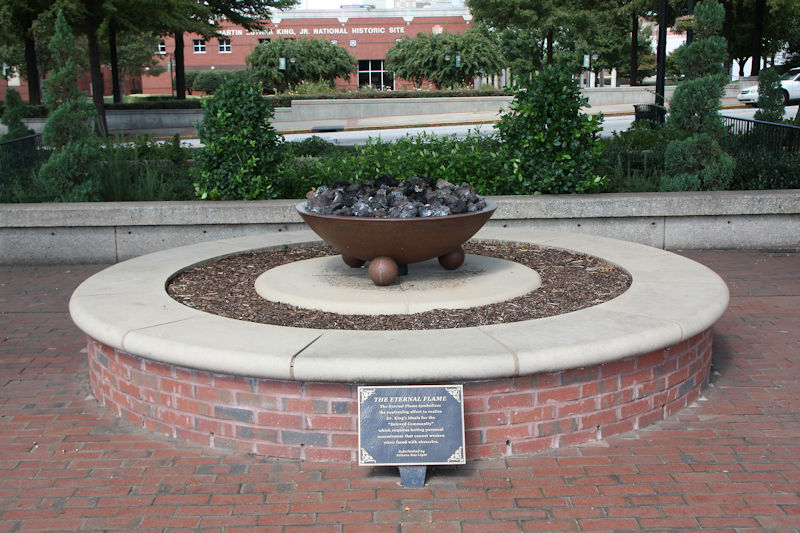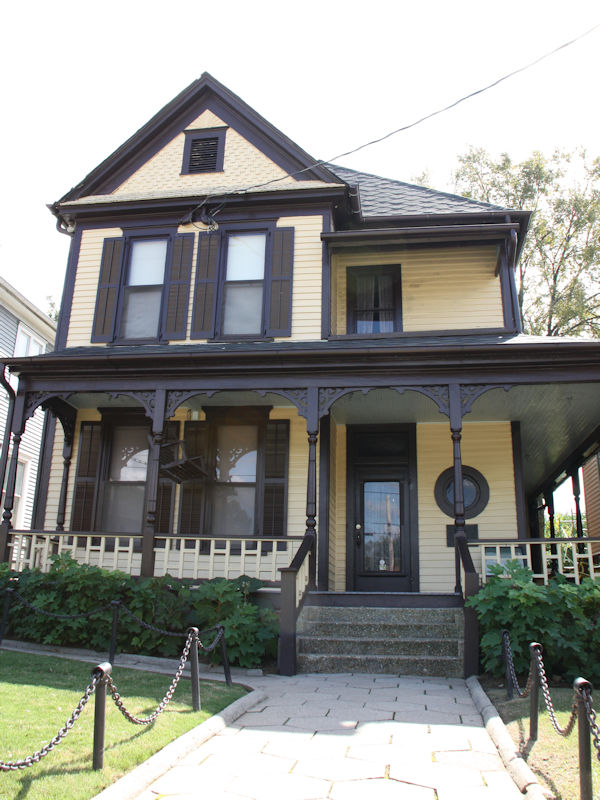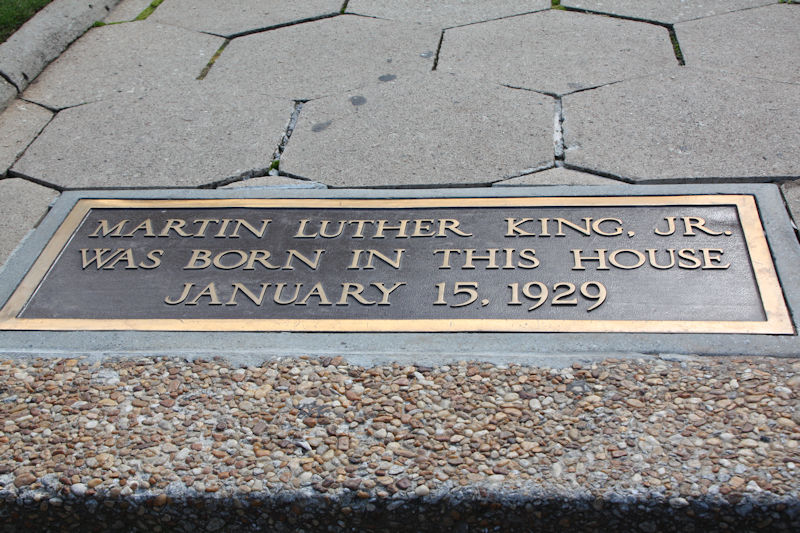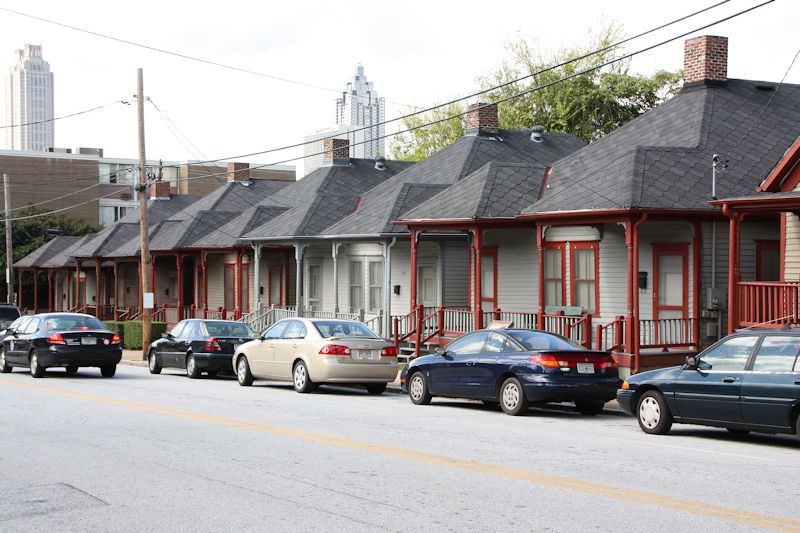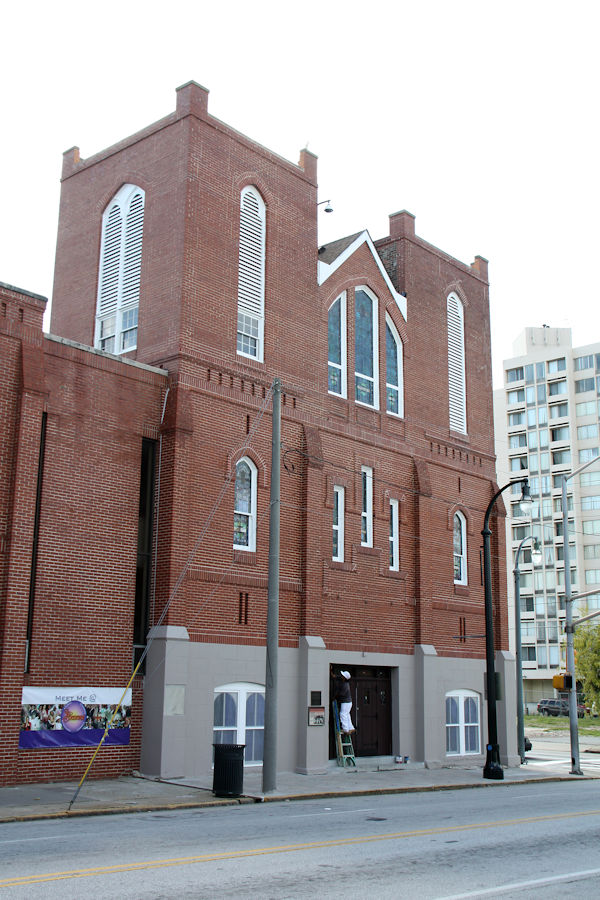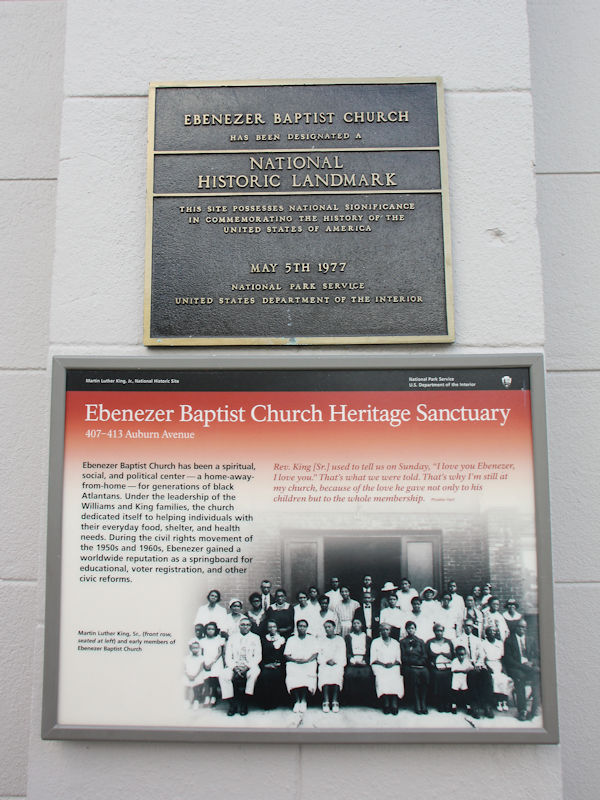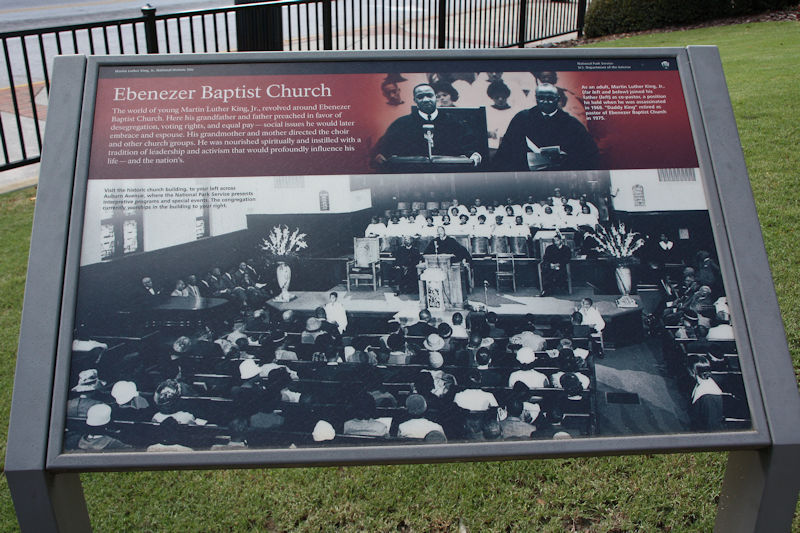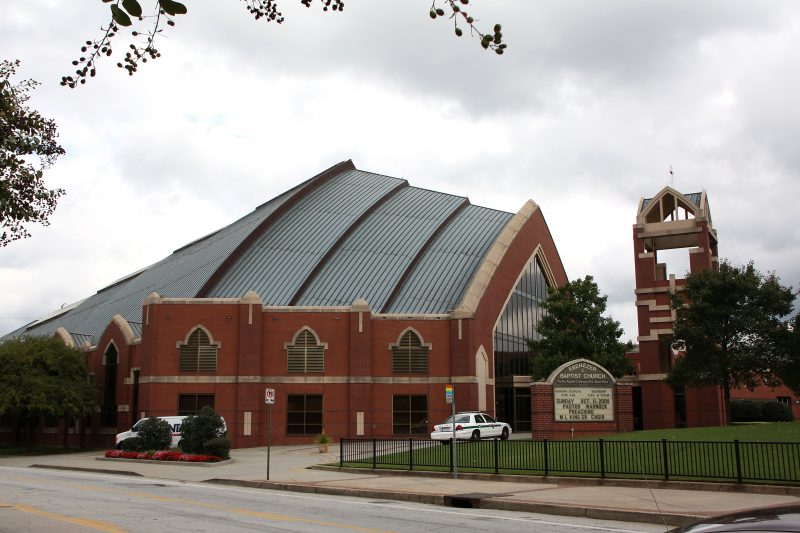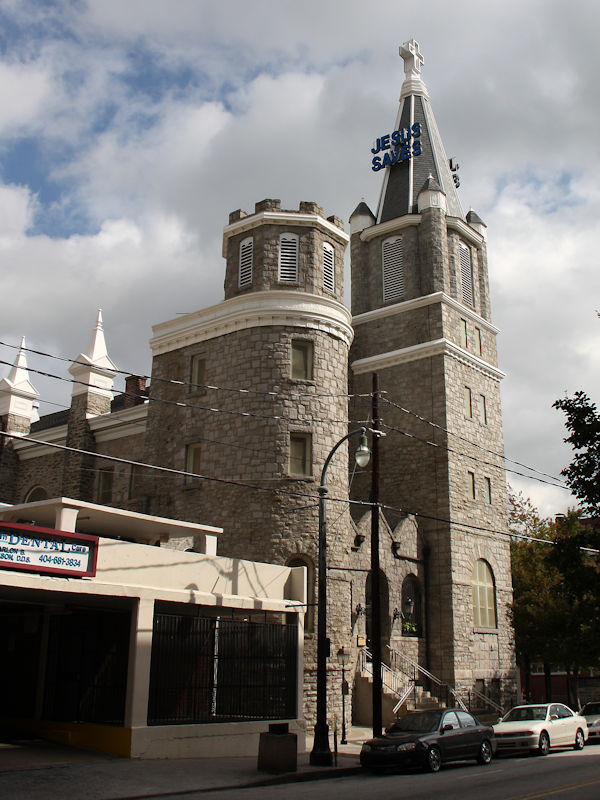Themed Photo Gallery and Information: Atlanta, Georgia
History
The history of Atlanta dates back to 1836, when Georgia decided to build a railroad to the U.S. Midwest and a location was chosen to be the line’s terminus. The stake marking the founding of “Terminus” was driven into the ground in 1837 (called the Zero Mile Post). In 1839, homes and a store were built there and the settlement grew. Between 1845 and 1854, rail lines arrived from four different directions, and the rapidly growing town quickly became the rail hub for the entire Southern United States. During the American Civil War, Atlanta, as a distribution hub, became the target of a major Union campaign, and in 1864, Union William Sherman’s troops set on fire and destroyed the city’s assets and buildings, save churches and hospitals. After the war, the population grew rapidly, as did manufacturing, while the city retained its role as a rail hub. Coca-Cola was launched here in 1886 and grew into an Atlanta-based world empire. Electric streetcars arrived in 1889, and the city added new “streetcar suburbs”.
The city’s elite black colleges were founded between 1865 and 1885, and despite disenfranchisement and the later imposition of Jim Crow laws in the 1910s, a prosperous black middle class and upper class emerged. By the early 20th century, “Sweet” Auburn Avenue was called “the most prosperous Negro street in the nation”. In the 1950s, blacks started moving into city neighborhoods that had previously kept them out, while Atlanta’s first freeways enabled large numbers of whites to move to, and commute from, new suburbs. Atlanta was home to Dr. Martin Luther King, Jr., and a major center for the Civil Rights Movement. Resulting desegregation occurred in stages over the 1960s. Slums were razed and the new Atlanta Housing Authority built public-housing projects.
From the mid-1960s to mid-’70s, nine suburban malls opened, and the downtown shopping district declined, but just north of it, gleaming office towers and hotels rose, and in 1976, the new Georgia World Congress Center signaled Atlanta’s rise as a major convention city. In 1973, the city elected its first black mayor, Maynard Jackson, and in ensuing decades, black political leaders worked successfully with the white business community to promote business growth, while still empowering black businesses. From the mid-’70s to mid-’80s most of the MARTA rapid transit system was built. While the suburbs grew rapidly, much of the city itself deteriorated and the city lost 21% of its population between 1970 and ’90.
In 1996, Atlanta hosted the Summer Olympics, for which new facilities and infrastructure were built. Hometown airline Delta continued to grow, and by 1998-9, Atlanta’s airport was the busiest in the world. Since the mid-’90s, gentrification has given new life to many of the city’s intown neighborhoods. The 2010 census showed affluent blacks leaving the city for newer exurban properties and growing suburban towns, younger whites moving back to the city, and a much more diverse metropolitan area with heaviest growth in the exurbs at its outer edges.
Main ‘History of Atlanta’ Wikipedia entry here: https://en.wikipedia.org/wiki/History_of_Atlanta
Main Atlanta Wikipedia entry here: https://en.wikipedia.org/wiki/Atlanta
Sweet Auburn
The Sweet Auburn Historic District is a historic African-American neighborhood along and surrounding Auburn Avenue, east of downtown Atlanta, Georgia, United States. The name Sweet Auburn was coined by John Wesley Dobbs, referring to the “richest Negro street in the world,” one of the largest concentrations of African-American businesses in the United States. A National Historic Landmark District was designated in 1976, covering 19 acres (7.7 ha) of the neighborhood, significant for its history and development as a segregated area under the state’s Jim Crow laws.
Sweet Auburn is one of 242 officially recognized neighborhoods of Atlanta. It is bounded by:
- Freedom Parkway and the Old Fourth Ward (formerly the separate Bedford Pine neighborhood) on the north
- Boulevard and the Old Fourth Ward on the east
- the MARTA East-West line and the Oakland and Grant Park neighborhoods on the south, and
- the Downtown Connector and downtown Atlanta on the west
The first settlement here was on land formerly occupied by Union troops and was called Shermantown for many years. It developed quickly being near the Georgia Railroad and in 1879 was at the endpoint of a newly graded road called simply Boulevard, which led from the railroad to North Avenue near Ponce de Leon Avenue and Angier Springs.
The rise of Auburn Avenue as “the” black business district in Atlanta was to a great extent an outcome of the 1906 Atlanta Race Riot. Prior to this time black businesses operated largely in downtown Atlanta — a business district integrated as far as business ownership was concerned. But competition between working-class whites and blacks for jobs and housing gave rise to fears and tensions. In 1906, print media fueled these tensions with hearsay about alleged sexual assaults on white women by black men, triggering the riot, which left at least 27 people dead (25 of them black) and over 70 injured.,
Black businesses started to move from previously integrated business district downtown to the relative safety of the area around the Atlanta University Center west of downtown, and to Auburn Avenue in the Fourth Ward east of downtown. “Sweet” Auburn Avenue became home to Alonzo Herndon’s Atlanta Mutual, the city’s first black-owned life insurance company, and to a celebrated concentration of black businesses, newspapers, churches, and nightclubs. In 1956, Fortune magazine called Sweet Auburn “the richest Negro street in the world”, a phrase originally coined by civil rights leader John Wesley Dobbs from the poem The Deserted Village by Oliver Goldsmith. Sweet Auburn and Atlanta’s black colleges formed the nexus of a prosperous black middle class and upper class which arose despite enormous social and legal obstacles.
Sweet Auburn was designated a National Historic Landmark in 1976. However, like so many other inner-city neighborhoods, Sweet Auburn fell victim to lack of investment, heavy, widespread crime, homelessness, and abandonment, compounded by construction of the Downtown Connector freeway that split it in two. In 1992 the National Trust for Historic Preservation recognized that it was one of America’s 11 Most Endangered Historic Places and, in 2005, the Georgia Trust for Historic Preservation included the area in its 2006 list of Places in Peril. The Historic District Development Corporation (HDDC) was formed to turn the trend around, starting with houses surrounding the birth home of Dr. Martin Luther King Jr., and working outward. In 2014, the city of Atlanta completed the installation of the Atlanta Streetcar, a line that creates a loop connecting the Martin Luther King Jr. National Historic Site to downtown and the tourist attractions of Centennial Olympic Park. The streetcar travels east along Edgewood Avenue and west along Auburn Avenue.
Several churches located along the avenue, such as Big Bethel AME and First Congregational, helped build and maintain the heritage of the street. The Royal Peacock Club provided an elegant setting where many African Americans could perform and bring the changing styles of black popular music to Atlanta. Originally called the Top Hat Club when it opened in 1938, the club hosted local talent and national acts such as B.B. King, the Four Tops, the Tams and Atlanta’s own Gladys Knight. One of the many significant commercial buildings within the district is the Atlanta Life Insurance Company. The second-largest black insurance company in the United States, Atlanta Life Insurance was founded in 1905 by Alonzo Herndon, a former slave from Walton County, Georgia. The central building of the Atlanta Life Insurance Company complex is a Beaux Arts building facing Auburn Avenue. The district also includes the Rucker Building, Atlanta’s first black-owned office building, constructed in 1904 by businessman and politician Henry A. Rucker. For more information about the less well known Henry Allen Rucker, visit The Atlanta History Center Archives and access Terminus, one of the center’s databases. (These collections contain data and images of nearly every notable African American in Atlanta and beyond dating from Reconstruction into the late 1970s.) Also located on Auburn Avenue was The Atlanta Daily World, the first black-owned daily newspaper, which was founded here in 1928. (The Atlanta Daily World is still the nation’s longest running African American newspaper.) In 1948, the Atlanta Police Department was integrated, hiring eight black police officers, all of whom were assigned to Auburn Avenue.
List of historical churches and businesses
- APEX Museum – founded in 1985
- Atlanta Daily World – founded in 1928
- Atlanta Life Insurance – founded in 1905
- Big Bethel AME Church – founded in 1847
- Ebenezer Baptist Church – founded in 1886
- Herndon Building (demolished following tornado damage, 2008)
- Martin Luther King’s birth home – established January 15, 1929 [9]
- Martin Luther King Jr. National Park Visitors Center – founded in 1980
- Odd Fellows Building and Auditorium – 1912–13
- Sweet Auburn Curb Market – opened in 1924
Sweet Auburn celebrates the annual Auburn SpringFest, and in the Fall, the Sweet Auburn Heritage Festival. The Sweet Auburn Heritage Festival is an annual festival held the first weekend in October on Auburn Avenue. Civil rights leader Hosea Williams founded the first festival in 1984. Charles Johnson founded the festival in 1994 as a way to celebrate the African American achievements as established on Auburn Avenue. The festival offers food, art, and entertainment throughout the day while celebrating Auburn Avenue’s past and growth, and is operated by the Sweet Auburn Committee.
The festival’s entertainment varies from comedians to up and coming artist from diverse genres of music. The Sweet Auburn Heritage Festival searches for entertainment from cities such as Atlanta, Macon, Savannah, Augusta, Huntsville and Chattanooga in hopes to help non- established artist’s path to stardom. Artist such as Usher Raymond, Outkast, India.Arie, and Raven-Symoné have started out performing on stage at the festival. Ultimately, the Sweet Auburn Heritage Festival entertainment has grown much farther than originally anticipated from its beginning stages in 1984.
Edgewood Avenue which runs through the heart of Sweet Auburn has become a hotspot for viewing for street art in Atlanta. Works by international artists such as Sten Lex and local artists such as Dr. Dax and Chris Veal can be found on Edgewood Avenue and the surrounding streets. Several of the Sweet Auburn murals can be found on the Atlanta Street Art Map.
The Auburn Avenue Research Library on African American Culture and History is an institution dedicated to preserving and highlighting African American culture and history.
Source: Wikipedia
Georgia Historical Markers
Photo Gallery
In 2009 we had planned a trip to Georgia flying into Atlanta and spending a few days visting the Sweet Auburn Historic Distict. Prior to going, Michael Gray (author of the book ‘Hand Me My Travellin’ Shoes: In Search of Blind Willie McTell’ – which I had been promoting on EarlyBlues.com ) emailed me to say he was going on a book signing tour of Georgia at the same time as we were going on our own tour, and unbelievably he was starting in Atlanta about the same time as us – what a coincidence! We looked at his itinery and discovoured his first talk was in Decatur whilst we were there. So we decided to support/surprise him by driving to the Decatur CD Store (356 W Ponce De Leon Ave, Decatur). As we drove into the parking lot another car pulled in beside us – yes, MIchael himself. We glanced at each other – big smiles from me and a very suprised and welcoming look from Michael!!
Firstly lunch here – excellent soul food – sadly the restaurant has now closed.
Martin Luther King Jr. National Historical Park
The Martin Luther King Jr. National Historical Park consists of several buildings in Atlanta, Georgia, including Martin Luther King Jr.’s boyhood home and the original Ebenezer Baptist Church, the church where King was baptized and both his father Martin Luther King Sr. and he were pastors. These places, critical to the interpretation of the life of Martin Luther King Jr. and his legacy as a leader of the American Civil Rights Movement, were included in the former national historic site established on October 10, 1980. The site was redesignated as a national historical park through a bipartisan bill long championed by John Lewis and signed on January 8, 2018, by President Donald Trump.
In total, the buildings included in the site make up 35 acres (0.14 km²). The visitor center contains a museum that chronicles the American Civil Rights Movement and the path of Martin Luther King Jr. An 1894 firehouse (Fire Station No. 6) served the Sweet Auburn community until 1991, and now contains a gift shop and an exhibit on desegregation in the Atlanta Fire Department. The “I Have a Dream” International World Peace Rose Garden, and a memorial tribute to Mohandas K. Gandhi are part of the site, as is the “International Civil Rights Walk of Fame” which commemorates some of the courageous pioneers who worked for social justice.
Annual events celebrating Martin Luther King Jr. Day in January typically draw large crowds. Speakers have included Presidents of the United States, national and local politicians, and civil rights leaders. Remembrances are also held during Black History Month (February), and on the anniversary of King’s April 4, 1968, assassination in Memphis, Tennessee.
Source: Wikipedia
Martin Luther King’s Birth Home
The King Birth Home is located at 501 Auburn Avenue in the Sweet Auburn historic district. Built in 1895, it sits about a block east of Ebenezer Baptist Church. King’s maternal grandparents, Reverend Adam Daniel (A.D.) Williams, who was pastor of the Ebenezer Baptist Church, and his wife, Jennie Williams, bought the house for $3,500 in 1909. In 1926, when King’s father married Alberta Williams, the couple moved into the house, where King Jr. was born in 1929.
The King family lived in the house until 1941. It was then converted into a two-family dwelling. The Rev. A. D. Williams King, Dr. King’s brother, lived on the second floor in the 1950s and early 1960s.
The first level includes the front porch, parlor, study, dining room, kitchen, laundry, bedroom and a bathroom. The second level includes four bedrooms and a bathroom. The visitor center offers free tours of the house led by National Park Service rangers, but with limited availability
Source: Wikipedia
These duplexes are typical of the houses where Atlanta’s blue-collar laborers lived in the early 1900s. The Empire Textile Co. built them for its white mill workers, but they moved out after the 1906 Atlanta race riot, and blacks began renting them. The houses generally are one room wide and up to four rooms deep. They are called “shotgun” houses because the interior and exterior doorways are aligned, so a shot supposedly could be fired through them from front to back. Another theory is that the name comes from the African word “to-gun,” which means place of assembly.
Source: Georgia Historic Markers
Ebenezer Baptist Church
Ebenezer Baptist Church is an evangelical Christian Baptist church located in Atlanta, United States, affiliated with the Progressive National Baptist Convention.
The church was founded in 1886 by Pastor John A. Parker and eight people. In 1913, the church had 750 people. In 1927, Martin Luther King Sr. became assistant pastor. In 1960, Martin Luther King Jr. became co-pastor of the church with his father until 1968.
In 1999, a new 1,700-seat church building called the Horizon Sanctuary was inaugurated on the site of the Martin Luther King Jr. National Historical Park.
Source: Wikipedia
See also: Old Ebenezer history https://ebenezeratl.org/history/
Marker text:
Ebenezer Baptist Church has been a spiritual, social, and political center – a home-away-from-home – for generations of black Atlantans. Under the leadership of the Williams and King families, the church dedicated itself to helping individuals with their everyday food, shelter and health needs. During the civil rights movement of the 1950s and 1960s, Ebenezer gained a worldwide reputation as a springboard for educational, voter registration, and other civic reforms.
Atlanta – MLK Historic Site: New Horizon Sanctuary
The New Horizon Sanctuary at Ebenezer Baptist Church, located across Auburn Avenue from the historic Ebenezer Baptist Church, was built in 1999. Architectural firm Stanley Love-Love, P.C. designed the 1,600-seat sanctuary, educational building, peace plaza, bell tower and prayer garden.
The Historic Ebenezer Baptist Church features a long history of civil rights, but is most famous for its association with Dr. Martin Luther King, Jr. It was here that Dr. King was baptized in 1936, gave his first sermon in the fall of 1947, and was ordained in February, 1948. He served as co-pastor with his father until he left to Crozer Theological Seminary in September 1948, and as Ebenezer’s associate minister during his breaks from Seminary and his doctoral studies at Boston University School of Theology through early 1954. Under Dr. King, Ebenezer was often the site of meetings and rallies, including the organizational meetings that led to the founding of the Southern Christian Leadership Conference in 1957. He later returned as co-pastor with his father, serving from 1960 until his assassination in 1968. On April 9, 1968, a private funeral service, filled with 1,300 people, was held for Dr. King at Ebenezer, followed by a three-mile procession to his alma mater, Morehouse College, for a public service. The church was founded in 1886 by its first minister, John Andrew Parker. In 1893 Reverend Adam Daniel (A.D.) Williams, the son of a slave preacher and Dr. King’s maternal grandfather, became the church’s second pastor. Under Williams, the church grew exponentially and moved twice before the current new church building was constructed from over an extended period of time, from 1914 to 1922, with some finishing touches not complete into the 1930’s and 40’s. No architect has been identified for the Late Gothic Revival design, although some oral traditions credit Rev. Williams. In 1933, Reverend Martin Luther King, Sr., took over as Ebenezer’s third pastor, a position he’d hold until his retirement in 1975. Alterations designed by Edward C. Miller in 1955-56 introduced the Christian Education Building, connected by an elevated walkway, a redesigned interior, and a baptismal pool. In 1970, Muldawer & Patterson in association with J.W. Robinson designed a new vestibule in front of the education building and made interior alterations. A four-year, 8-million restoration returning the church to its 1960’s appearance was completed in 2011.
The Martin Luther King, Jr. National Historic Site, an area of about 2 blocks around Auburn Avenue, was established by the National Park Service (NPS) on October 10, 1980. The historic site includes King’s gravesite; the historic Fire Station No. 6; the “I Have a Dream” International World Peace Rose Garden; and the International Civil Rights Walk of Fame.
The Martin Luther King, Jr. Historic District, an area bound roughly by Irwin, Randolph, Edgewood, and Auburn Avenues, was established in 1974 and later, in 1977 designated a national historic landmark, and expanded in 2001. The district encompasses the environs in which Martin Luther King, Jr., grew up from his birth in 1929 until he left Atlanta.
Martin Luther King, Jr. National Historic Site and Preservation District National Register #80000435 (1980)
Martin Luther King, Jr. Historic District National Register #74000677 (1974)
Source: https://www.flickr.com/photos/wallyg/9012273754
Big Bethel AME Church
The Big Bethel AME Church is the oldest African-American congregation in the Sweet Auburn neighborhood of Atlanta, Georgia, and according to AME historical documents, it is the mother church of AME in North Georgia. It is located at 220 Auburn Avenue NE in the Sweet Auburn neighborhood. It is the “first” church on the North Atlanta District, in the Atlanta-North Georgia Annual Conference of the African Methodist Episcopal Church.
Big Bethel was founded in 1847 as Union Church in the town of Marthasville, Georgia. Marthasville became Terminus, and finally Atlanta, and Union Church became Bethel Church, then Bethel Tabernacle. At the close of the Civil War, the AME Church spread rapidly throughout the former Confederacy, and the Bethel Tabernacle allied herself with the denomination, becoming Bethel African Methodist Episcopal Church. Her first pastor was Rev. Joseph Woods.
In 1879, the first public school for blacks in Atlanta, Gate City Colored School, was founded in the basement of the church, though it would later move to Houston Street. Morris Brown College held its first classes here in 1881 before moving to its first campus. Big Bethel was known as “Sweet Auburn’s City Hall.” In 1911, President William Howard Taft spoke here, as did Nelson Mandela in 1990.
Source: Wikipedia
